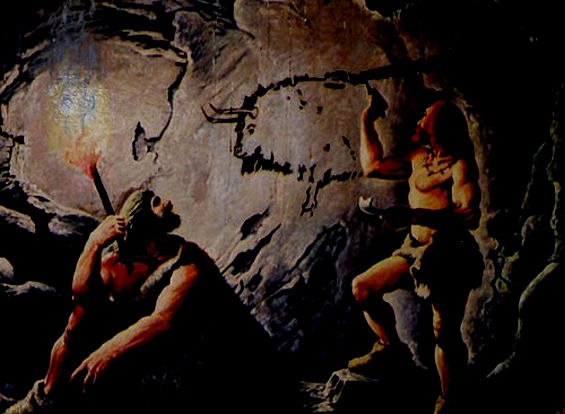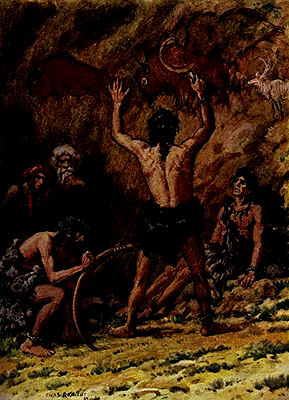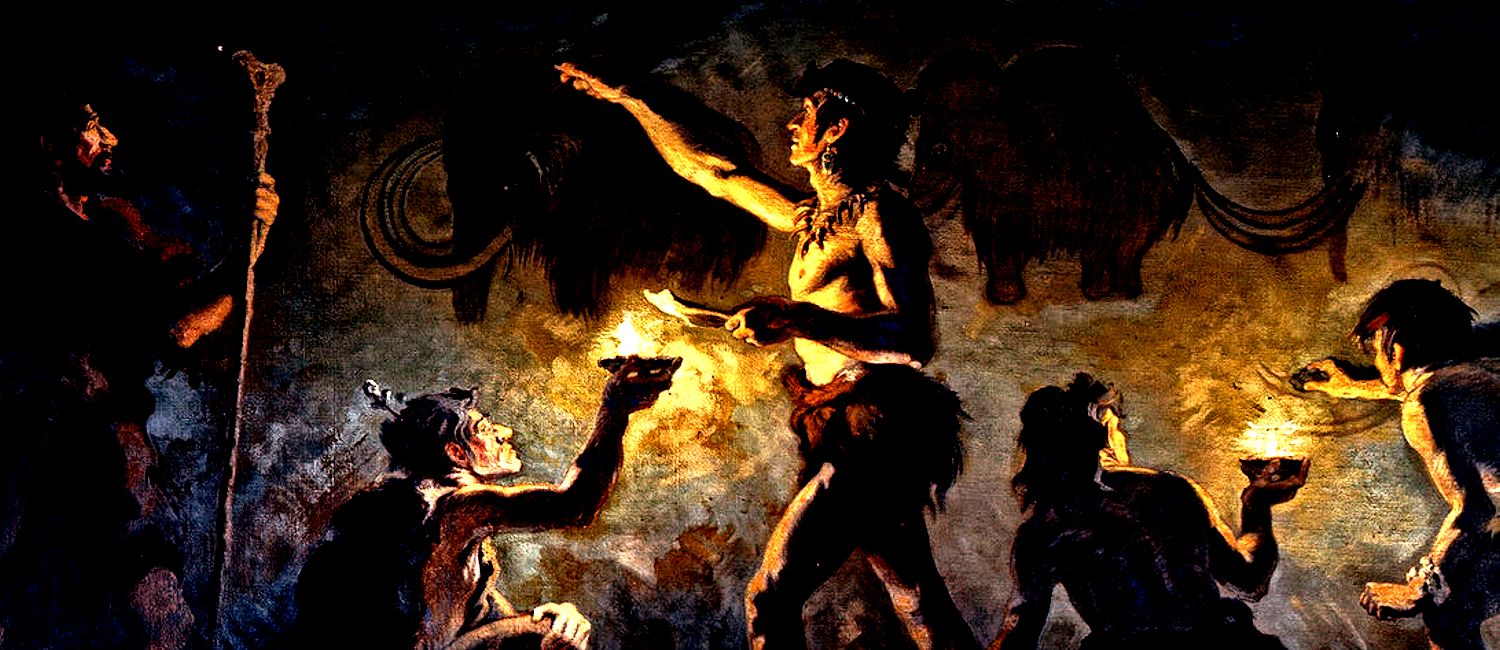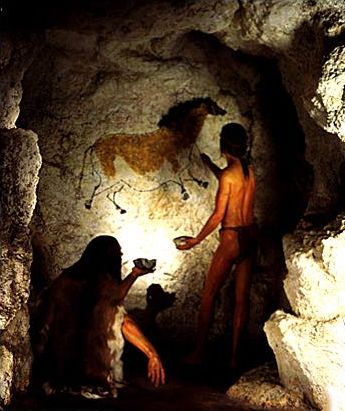Cave Art consists of engraved or painted works on open air rocks or on the floors, walls and ceilings of caves, some of them in deep and almost inaccessible crannies. They were created during the Upper Palaeolithic period (40,000 to 10,000 BC), and the best were done by what we call the Magdalenians (from the name of a site), peoples who flourished in Europe from 18,000 to 10,000 BC.
Such works have a unity, and can be described as the Magdalenian art system, the first in human history. it was also the longest, lasting for more than two thirds of the total time when humans have produced art. In any history of art, then, the Magdalenian system must occupy a place of importance. Alas, of all the forms of art practised on the planet, it is the one about which we know the least. But our knowledge is by no means derisory, bearing in mind that the first cave art was only discovered in the 186os, and it was not until 1902 that it was accepted as a fact by anthropologists and art historians. By the end of the twentieth century, there were 277 agreed examples in Europe, 142 in France, 108 in Spain, 21 in Italy, 2 in Portugal, 2 in Germany and 2 in the Balkans. Unfortunately, most of these works of art are extremely fragile. When a cave is ‘opened’, and the conditions which enabled paintings to survive are altered, deterioration can be rapid. The superb paintings found at Bédeilhac in the Pyrenees during the First World War disappeared completely within six months of the cave’s discovery. Thus except in places where expensive air conditioning has been installed, caves are no longer open to the public. Even the Altamira Cave in Spain, finest of them all, is now open only to small parties for brief periods. Scholars themselves find it difficult to gain admission. Some of these works are photographed but the camera gives a poor idea of their nature and quality. Some are difficult to see anyway: the best part of Altamira has to be studied lying down. Hence inaccessibility is a real and growing obstacle to unlocking the secrets of the Magdalenian art system.

However, here are a few items of knowledge on which we can build, beginning with subject matter. Cave art portrays human hands; large numbers of animals in different activities, including various species, such as the woolly rhinoceros, which are now extinct, and a few which were extinct even at the time they were painted; geometric figures and signs. Humans are also portrayed but these instances are rare. Next we come to methods and materials. The earliest and most rudimentary images are finger drawings in soft clay on the rock surface, the artist following the example of claw marks made by animals. Then came engraving, by far the commonest method, using flakes of sharp flint and in some cases stone picks. Different types of rocks, and rock formations, were used to give variety, add colour and produce depth, so that some of these engravings are akin to sculptural low reliefs. Fine engraving is rare and late. Clay engraving on the cave floors has usually been obliterated by the feet of modern visitors, but some good examples survive. Finally, and most impressively, we get painting. The first colours were red, iron oxide (hematite, a form of red ochre) and black (manganese dioxide), though black from juniper or pine carbons has also been discovered. White from kaolin or mica was used occasionally. The only other colours available to Magdalenian painters were yellow and brown.
However, great ingenuity was displayed by artists. At Lascaux we have found pestles and mortars in which colours were mixed, together with no less than 158 different mineral fragments from which the mixtures were made. There seems to have been no shortage of pigment large lumps have been found at some sites. Shells of barnacles were used as containers. One master employed a human skull. Cave water and the calcium it contained were used as mixers, and vegetable and animal oils as binders. The artists had primitive crayons and they applied the paint with brush tools, though none has survived. All kinds of devices and implements were used to aid art. Important lines were preceded by dots, which were then Joined up. Sometimes paint was sprayed. Stencils were used. Blow pipes made from bird bones served as tubes for applying paint. By these means, the more experienced Magdalenian painters were able to produce polychrome art.

Now let us look at sites. Stone Age peoples did not live in caves, except occasionally in cave mouths or natural rock shelters. All the major sites which we know of were special places, not human habitations. Magdalenian artists did produce work in the open air, six examples of which, all engravings, have survived. But the vast majority of open air work has of course disappeared. Caves were used because they were shelters and the art executed in them would be preserved. This brings us to duration. Some of the Magdalenian art work was ephemeral or the result of practise exercises by apprentices. But the fine art engravings and paintings were evidently made to last, and did last, in some cases for hundreds or even thousands of years, during which they were available for delight and use. A big cave gallery thus contained work done over a long period, available for comparison or instruction to people who had some notion of historical time and were developing a sense of their ancestry. The best Magdalenian art, especially the polychrome paintings, was the work of professionals. Indeed, it is likely that art was the first of the human professions.
We can say this with confidence, for cave art at its best was difficult and expensive to produce. ln the first place, it required lighting. Some eighty five certain and thirty one probable examples of Palaeolithic lamps have survived but less than one third of them were found inside caves. The conjecture, therefore, is that artists usually worked by torchlight. Both lamps and torches consume animal fats in large quantities. Second, while it is true that some of the best cave paintings, especially at Altamira, were painted by artists standing up or in some cases lying down or squatting, others required elaborate scaffolding, no different in principle from that used by Michelangelo when painting the ceiling of the Sistine Chapel. Some of the paintings were done on a gigantic scale or at heights many feet from the cave floor. At Labastide in the Pyrenees, an immense horse is found 14 feet above floor level. At Bernifal in the Dordogne, the mammoths are painted 20 feet up. Some of the bulls at Lascaux are over 20 feet long. The famous painting of a woolly rhinoceros at Font de Gaume, whose accuracy was first disputed but then confirmed when a wellpreserved example of this supposedly mythic creature was unearthed in 1907 in a bitumen deposit in Poland, is found high up on a huge cave wall. The sheer scale of the art is daunting. The big cave vault at Lascaux, known as the Picture Gallery, is over 100 feet long and 35 feet wide. Caves were specially chosen for their size as well as for their security. Niaux in the Pyrenees is over half a mile in length, and this is by no means unusual. The big cave in Rouffignac runs over 6 miles into the mountain, and some of its huge collection of drawing engravings are nearly 7 feet long.
The professional artists, then, needed not only platforms and scaffolding, whose existence at Lascaux, for instance, is betrayed by sockets cut into the walls, but assistants. They mixed the paints, some of which had to be used quickly before they dried, filled the lamps or held the torches, put up and secured the scaffolding, and made the brushes, from twigs, feathers, leaves and animal hairs, to the satisfaction of the master. These assistants graduated into painters themselves. It is not going too far to speak of a studio system as the basis of Magdalenian art, After all, there is positive evidence that art studios, where important works were fabricated and apprentices trained, existed in Egypt from at least as far back as 3000 BC. That still leaves a gap Of 7,000 years from the end of the Magdalenian period. But the quality and consistency of the best painted work in caves, and the evidence of the time, expense and skill required to produce them, does suggest that artists needed the collective support of something very like a studio. The probability is that the leading cave artists were great men who gave themselves airs. And why should they not?
This brings us to quality. To modern eyes, accustomed to 5,000 years of continuous development in the depiction of living forms, from the Old Kingdom of ancient Egypt to the modernist art of the twentieth century, the best of the Magdalenian paintings are magnificent. Indeed, seen in the depth and total silence of the caves, the images are awesome. Human forms are rare and often quite unsophisticated. But the variety of animal forms is impressive. In the eight galleries of the great cave at Les Eyzies, there are multiple examples of mammoths, reindeer, horses, stags, bison and wolves, as well as humanoids and abstractions or signs. These interlocking galleries, unfolding one by one, are meant to impress, and they do. The art is both detailed and monumental, oscillating designedly between simplification and elaboration, between stasis and extreme dynamism. Some Magdalenian artists clearly understood both the anatomy of the animals they depicted and their principles of motion, the result of intense observation over many years and of a self discipline in rendering which suggests a long apprenticeship and extensive study.

There is nothing premeditated, amateurish or provincial about this high art. The sheer bulk of these wild creatures, their untamed ferocity, their liberty of movement, their power but also their elegance, expressed in the tapering balance and apparent lightness of their limbs, is conveyed with masterly precision and economy of line. The tonal qualities, and the ingenious use of surfaces in the rock, suggest depth and even a kind of perspective. If we take into account the freshness of the pigments when the work was just done, and the impact of the lines and colours under the flickering light of primitive oil lamps, or flambeaux, we can imagine the force of the impact which this first artistic experience had on primitive humans, whose innocent eyes were unaccustomed to visual forms outside nature itself. That helps to explain why Magdalenian societies were prepared to devote such a high proportion of their scarce surplus resources to the creation of these art galleries.
But what were these deliberately engineered and carefully contrived experiences designed to convey? What was the purpose of Magdalenian art? The answer is: we do not know, and we may never know. The earliest explanation was that they were the evening doodles of hunters, with no systematic purpose, spiritual, religious, utilitarian, totemic or even aesthetic. Then, throughout the twentieth century, eminent scholars the Abbé Henri Breuil, Max Raphael, Annette Laming Emperaire, Andre Leroi Gourhan, Reynaldo González Garcia and others devoted many years to formulating, elaborating and proving theories of use. These are contradictory and often mutually exclusive, and all have been eventually invalidated by fresh discoveries which do not fit. The utilitarian theory has been most generally held. But if the art was designed to teach the science of hunting, why did it include creatures already extinct or others that were never hunted? Why did it not include specific hunting scenes? In any case, anyone who has actually hunted knows that its skills are acquired not by studying pictures but by practise, something in which primitive peoples engaged from earliest youth, indeed childhood. Non utilitarian theories see the art as shamanistic, or magical or religious. But none of these fits all, or most or even many of the facts. There are no sacrifices depicted. Humans, almost always the central point of early religious art systems, scarcely figure at all. With one possible exception, the art shows no priest or sorcerer or witch doctor. There is nothing which could be termed a ceremony. An immense amount of classification and taxonomy has been performed on the caves and their contents, and elaborate timeschemes have been worked out. But these chronologies provide the appearance of knowledge rather than its reality. The earliest explanation seems as likely to be true, or untrue, as the later ones. We are a huge distance from Magdalenian society and its mentality, and finding answers to its mysterious actions requires an effort of imagination which may be beyond us.
 The most likely reason why these societies devoted so much attention and resources to cave art, over so long a period, is that they found satisfaction in it. It gave them entertainment, fun, excitement, sensual and spiritual relief, and added to their knowledge. In a long age which moved forward with excruciating slowness and in which few perceptible gains were made in a whole lifetime, the development of art was proof that life did not stand still. As the best artists were professionals, and required support and materials provided by the community, the art galleries they created in caves were communal possessions, to be visited as a right but also as a privilege, in a spirit of reverence and loyalty, dignity and gratitude, for the benefits which organised society brought. They were a cohesive factor.
The most likely reason why these societies devoted so much attention and resources to cave art, over so long a period, is that they found satisfaction in it. It gave them entertainment, fun, excitement, sensual and spiritual relief, and added to their knowledge. In a long age which moved forward with excruciating slowness and in which few perceptible gains were made in a whole lifetime, the development of art was proof that life did not stand still. As the best artists were professionals, and required support and materials provided by the community, the art galleries they created in caves were communal possessions, to be visited as a right but also as a privilege, in a spirit of reverence and loyalty, dignity and gratitude, for the benefits which organised society brought. They were a cohesive factor.
Art thus created by gifted individuals the main ‘ceiling’ at Altamira seems to have been the work of one artist on behalf of the entire settlement was also an intellectual instrument, which encouraged discussion or storytelling, accounts of exploits and the history of the community. It played a creative role not merely in general education but more specifically in the development of sophisticated language, being capable of communicating thoughts on an ever widening range of subjects. It is likely too that cave art promoted the birth of a religious spirit. There is nothing in these art works as such to suggest religious purpose. But the conditions in which they were viewed, flickering torches bringing to life these fine representations with their deep colours out of the surrendering darkness, induced a sense of wonder and reverence. And as the people marvelled at the way artistic skills could re create nature, they became aware of the even greater miracle of nature itself, in the vast world beyond the cave, and asked themselves: who could it be who created that? Thus cave art was thought provoking, and the thoughts it provoked provided the impetus for men and women to lay the foundations of theories of life, and of the universe. Precisely because of its non material, its metaphysical qualities, art became the father of religion.

